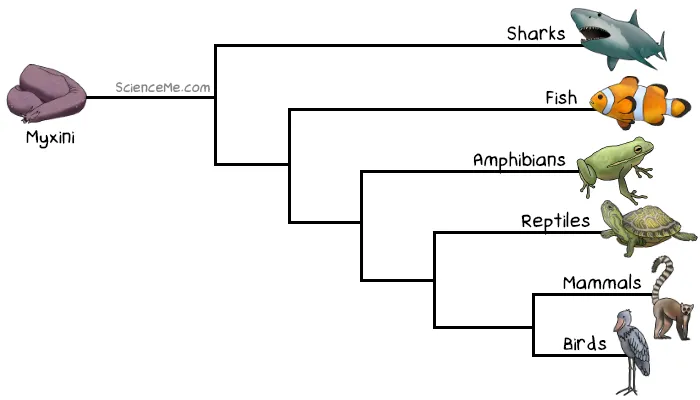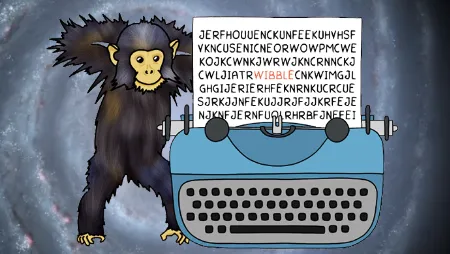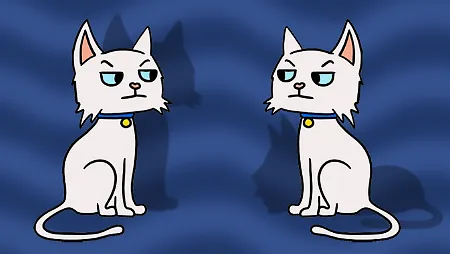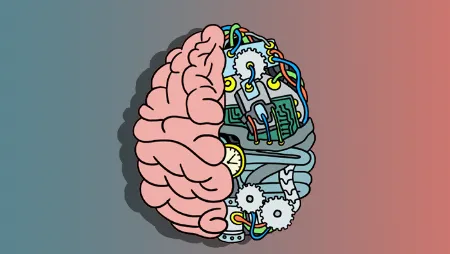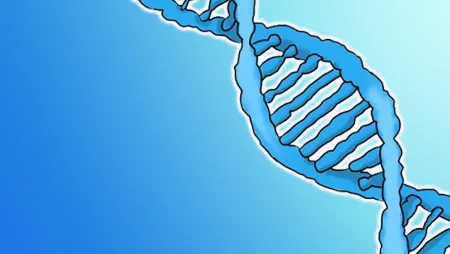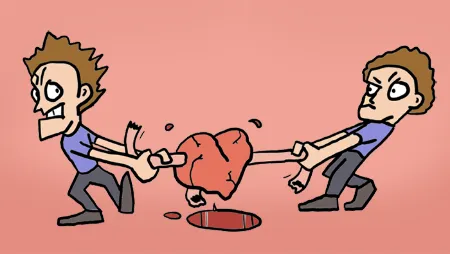Evolution—the development of new biological traits over many generations—gave us a lot of cool features. Bones, limbs, eyes, teeth, brains, and even creativity all came about at the hands of this trial-and-error process.
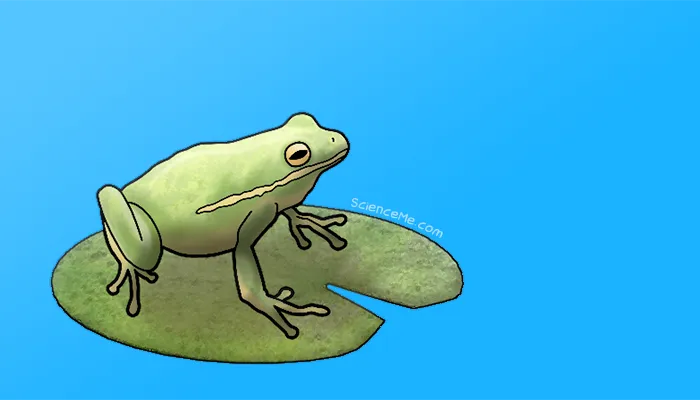
It all starts with our DNA: our molecular source code. When they don't directly kill us, random mutations in our DNA have us testing out new features, from neurochemicals to nephrons to neuroticism. Those features that help our DNA survive then proliferate through the population.
Like memes, new genes ripple through a population until, eventually, everyone is familiar with them.
That's the fundamental mechanism of evolution by natural selection. So how did it play out in the development of animal life on Earth? Today we'll visualise the course of animal evolution in 16 major steps, cutting a path from the first clumps of cells wobbling about in the ocean to the hairy bipeds we are today.
#1. The Evolution of Multi-Cellular Animals
We begin around a billion years ago, when single-celled organisms known as choanoflagellates hit on the idea of living in colonies. This simple behavioural change, based on the tendency to clump together rather than drift apart, marked the very beginning of all animal life on Earth.

Single-celled choanoflagellates are still alive today, looking very much like the simplest animal cells.
In time, choanoflagellates took on specialised roles within the colony. Some filtered food particles from the ocean. Some transported food to other cells. Some secreted fibres to create a protective structure.
This is how multicellular animals evolved. Do you know what animal this is yet? No, because it's too weird. To give you a hint: you probably have a synthetic version of one in your shower.
Oh alright. It's a sponge. You may not think of sponges as animals, but zoologists wholeheartedly disagree. While sponges have no brains, blood, organs, or even true tissues, they are distinctly made of differentiated animal cells working together. Roald Dahl had it right when he named Aunt Sponge. This is your most distant animal relative in the world.
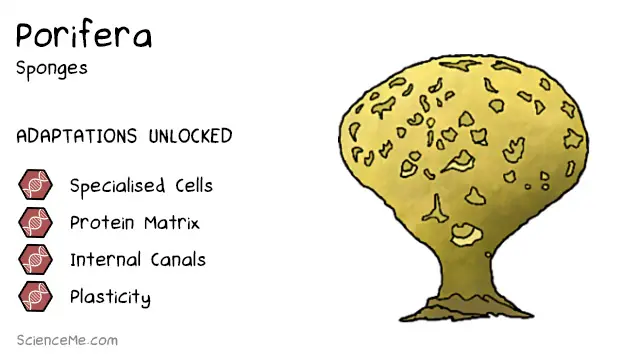
#2. The Evolution of Radial Symmetry
As sponges mutated and gained complexity and size, some of them took on new qualities like softer bodies and radial symmetry. This symmetry gave them a distinct top and bottom.
A new phylum of animals emerged, called Cnidaria. They include all jellyfish, hydras, anemones, and corals around today.
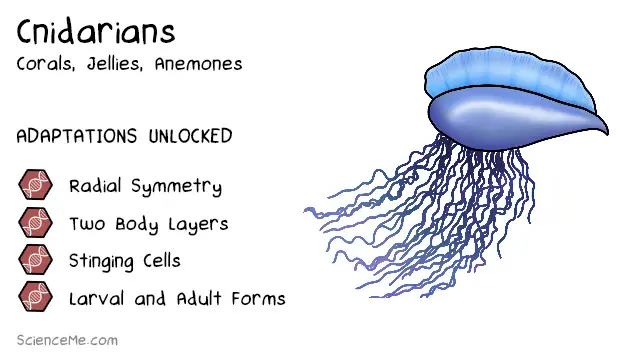
Cnidarians are aquatic animals with specialised stinging cells, called cnidocytes, which help them capture food actively. Stinging cells marked the dawn of predatory behaviour in animals up to 580 million years ago, kicking animal evolution into an arms race.
Also for the first time on Earth, animals boasted distinct tissue layers, giving them an internal body cavity for digesting food and transporting nutrients. Now that's some fancy biological equipment.
#3. The Evolution of Bilateral Symmetry
Over millions of years, Cnidarians diversified further into exotic forms. It's thought that hydras evolved into flatworms, of the phylum Platyhelminthes. The major new evolutionary feature of flatworms was bilateral symmetry.
Bilateral symmetry gives an animal mirrored left and right sides. You and I have bilateral symmetry. It's a massively useful adaption that led to the development of a head-end, also known as cephalisation.
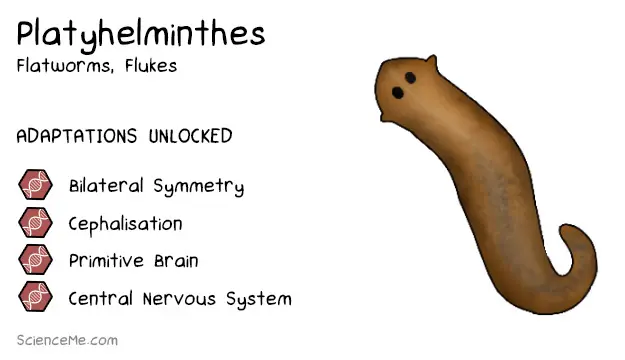
Until this point, radial symmetry suited a lifestyle of drifting through the ocean, meeting the environment equally from all sides. But bilateral symmetry and cephalisation lent animals to active movement. They encountered their environment head-on, where all the sensory equipment was located.
With eyes and mouths at the head-end, nerve bundles also became more usefully concentrated in the head too. These clusters of nerve cells produced the first primitive brains.
#4. The Evolution of Parasitism
Parasites go way back. It's hypothesised that Nematodes evolved from animals whose development was arrested in the larval stage. However, their true age and precise lineage is unknown because their fossilised remains are just so damn small.
Nematodes are tiny critters, known for their cylindrical bodies and adaptability to a diverse range of habitats. Different species are content living deep in the Earth's crust, in the ocean, or in your gut.
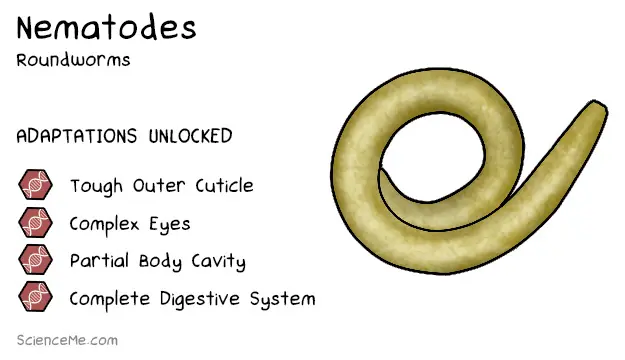
One evolutionary superpower of Nematodes is a tough outer coating called a cuticle which protects their inner organs.
They also hit on the parasitic lifestyle, stealing energy directly from their hosts. Roundworms are simple yet highly adaptive creatures, and that's precisely what makes them so successful.
The Cambrian Explosion
Half a billion years ago, there was a biological Big Bang. The evolutionary tree of animals spawned myriad new branches, including dozens of new animal phyla. All the major body plans we see in animals today emerged during this incredible period of animal evolution. So what kicked it all off?
The Cambrian Period started around 540 million years ago and lasted for about 55 million years. The idea of it being a Big Bang or an explosion is somewhat of a relative metaphor, but in terms of evolution, a lot happened over a very short time.
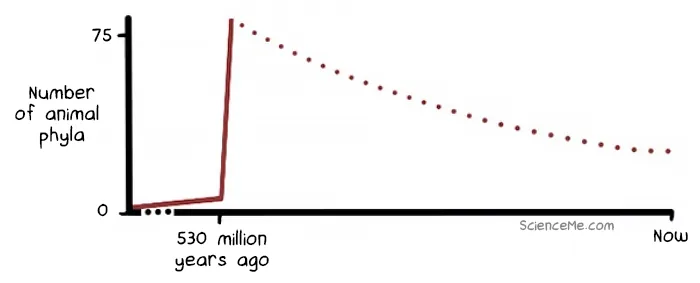
The fossil record shows an explosion of animal diversity during the Cambrian era.
At the start of the Cambrian era, Earth was cold. But soon, global temperatures climbed, glaciers melted, and sea levels rose.
The shrinking ice sheets allowed more light to penetrate the oceans, having major consequences on aquatic life:
- More sunlight fuelled more aquatic plants
- More plants provided more food and oxygen
- More food and oxygen fuelled bigger animals
The Cambrian Period was a perfect storm of abiotic (non-living) factors like climate and topography, interacting with biotic (living) factors like the food web and predation. Such feedback cycles drove the rapid diversification of the animal kingdom.
As you'll see in the next few phyla, the rapid co-evolution of animals pushed predators and prey into an arms race. Predators grew bigger, stronger, and faster, while prey developed camouflage, protective shells, and faster reflexes.
#5. The Evolution of Shells
Sometimes when you walk along the beach you find a really nice shell. These are not geological fancies but rather the calcium carbonate shells of dead Molluscs. That's right—beaches are mass snail graveyards.
The evolutionary features of Molluscs include soft bodies which excrete a hard protective shell. Most species are aquatic (like clams, oysters, and squid) although some live exclusively on land (like your standard garden snail).
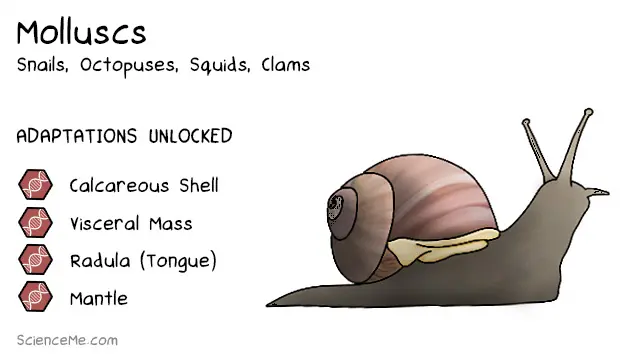
Wait a minute, Columbo, did you just say squid?
Yep, squid are Molluscs too. The squid has a small ancestral shell, called a gladius, which became internalised in the course of its evolution. The gladius supports the mantle and serves as a point for muscle attachment.
Squid are incredible animals that independently evolved eyes. And they can grow huge: up to 14 metres in the case of the colossal squid. They're closely related to octopuses, who not only have three hearts and blue blood, but also demonstrate problem solving and tool use.
#6. The Evolution of Body Segments
The early Cambrian Period gave rise to a lot of worms. Annelids, including marine worms and deliciously slimy earthworms, evolved distinct body segments, each one internally and externally identical to the next.
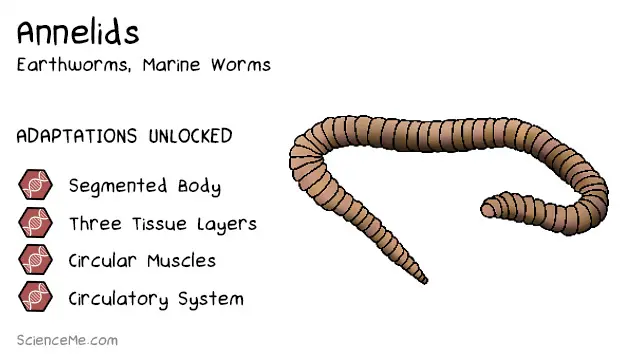
Some marine annelids evolved tiny paddle-like feet for swimming, which would later enable them to push through soil on the land. In time, the evolution of Annelids would create an enormous range of body sizes, from 0.5-millimetre aquatic worms to 3-metre Giant Australian Earthworms.
#7. The Evolution of Appendages
The paddle-like feet of marine worms kicked off an incredible phylum, members of which reside in your home today: Arthropods.
The three main lineages of arthropods are spiders, insects, and crustaceans. Together they account for 80% of all animals on Earth today. In other words, Arthropods rule.
Arthropods first appeared when some Annelids evolved into tiny crustaceans called ostracods, or seed shrimp. Homeobox mutations saw their paddles develop into jointed appendages which later specialised to function as antennae, pincers, mouth-parts, and legs.
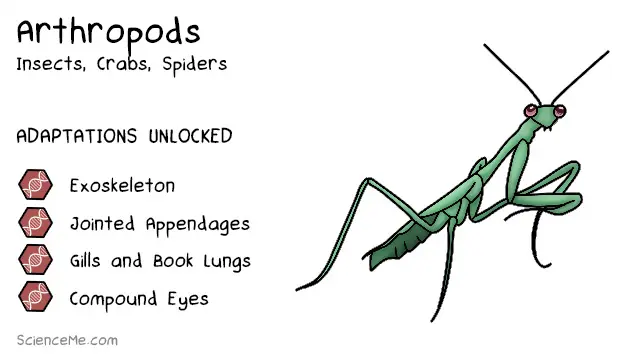
Some Arthropods prospered in the water: shrimp, trilobites, and sea spiders still flourish there today. Crabs adapted to spend part of their days on land. Spiders, scorpions, and beetles went terrestrial full-time. And land-dwelling species gave rise to flying insects like bees, butterflies, and mosquitoes.
Arthropods make up a huge and diverse phylum. Yet they all share key features which allow us to trace their common descent. They're exceptional at mastering life on Earth, being the only phylum to truly conquer land, sea, and air.
#8. The Evolution of Deuterostomes
All the animal evolution we've seen so far involves an embryonic stage known as protostome development. It characterises the way embryonic cells are organised to produce a basic body plan with various internal layers.
If we took a spider embryo when it's just eight-cells small, we'd see the cells arranging themselves in a spiral shape. These cells multiply many times to form a hollow sphere, and then fold inwards to create the beginning of the animal's mouth.
The Cambrian boomers changed all that, ushering in a new era of embryonic growth called deuterostome development 500-600 million years ago. You and I are deuterostomes. Our eight-cell stage is defined by a radial pattern, and later, the first infolding is set to become the anus.
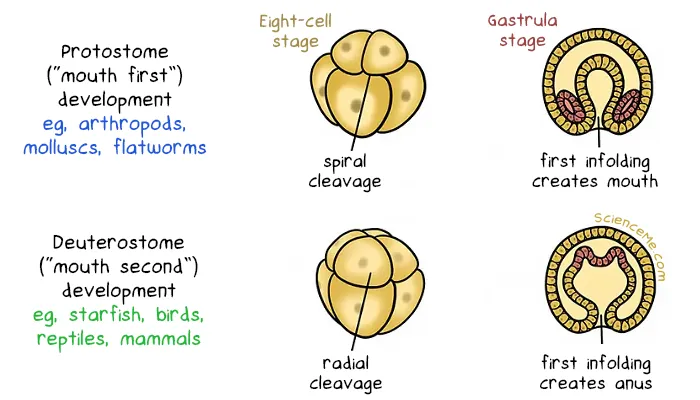
The hallmarks of protostome vs deuterostome development in animals.
Why does this matter? Because it changes the way our internal layers form. Deuterostome development affords us more a complex nervous system and, ultimately, a backbone. This is what separates vertebrates from invertebrates. And it's all thanks to mutations in the homeobox genes.
Starfish and sea urchins (aka Echinoderms) were the first animals to evolve deuterostome development, some 540 million years ago.
You read that right. Sea stars are pretty advanced animals in the grand scheme of things. They're not vertebrates, but they do mark a key transition state towards it during the course of animal evolution.
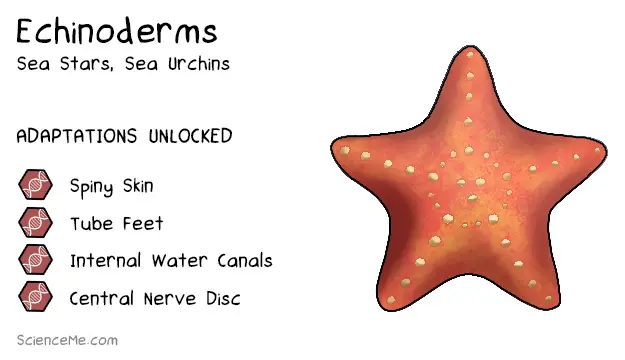
Besides their evolution as deuterostomes, Echinoderms boast an internal water canal system and tube feet which together enable movement and feeding. They also reproduce sexually by releasing sperm into the ocean, as well as asexually by breaking off limbs and regenerating. Amazing.
#9. The Evolution of Chordates
With a more complex mode of embryonic development at hand, a new phylum called Chordates evolved. It includes a few more bizarre animals, plus many all the familiar ones like dinosaurs, ducks, and dingoes.
Chordates have four key features:
- Hollow nerve chord = brain and spinal chord
- Flexible notochord = early backbone
- Pharyngeal slits = gills/inner ear
- Post-anal tail = for swimming and balance
At a glance, early chordates don't look that special. Take a look at the sea squirt or Urochordate. The larval form has all the Chordate features as a tadpole-like creature in search of a landing pad. This immature stage may only last a few minutes. Then something freakish happens.
The sea squirt undergoes a radical metamorphosis, re-absorbing its tail, notochord, and primitive brain back into its body. The rest of its days are spent as an immobile little squirt, siphoning water to filter food, and looking like a gross internal organ while it does so.
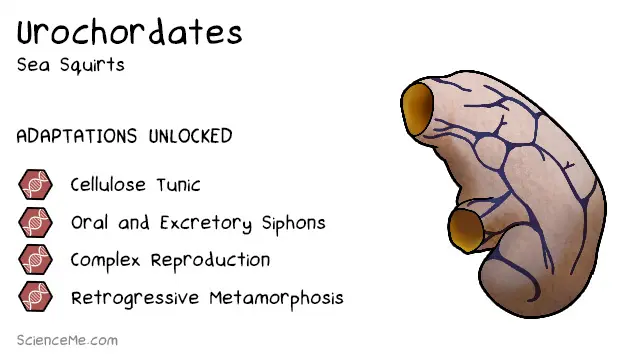
Another early Chordate example is the Lancelet, or Cephalochordate. This is a blade-like critter that burrows backwards into the sand, leaving its mouthparts exposed to catch drifting food particles.
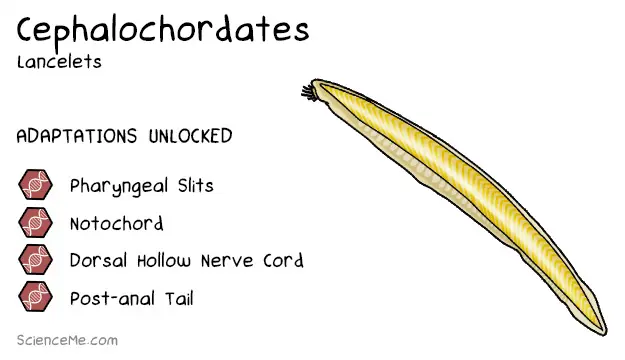
Lancelets have no true vertebrae, their brains are small and primitive, and they have pretty dull senses. Yet they do have all the features of Chordates like you and me, reminding us that evolution is a gradual process of cumulative adaptation.
Having glimpsed some of the more alien-like animals throughout evolution, we now move on to the more familiar. But before we delve into vertebrates, just look how far we've come:
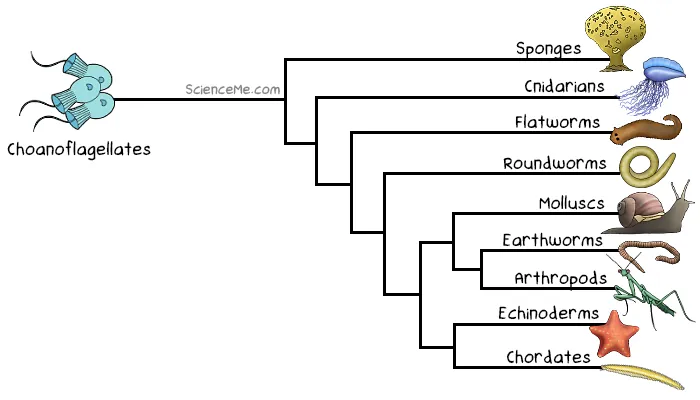
#10. The Evolution of Backbones
Take a look at this beauty queen. The 500-million-year-old hagfish, or Myxini to zoologists, is basically a swimming sausage. She's a jawless gal with a partial skull and produces defensive slime.
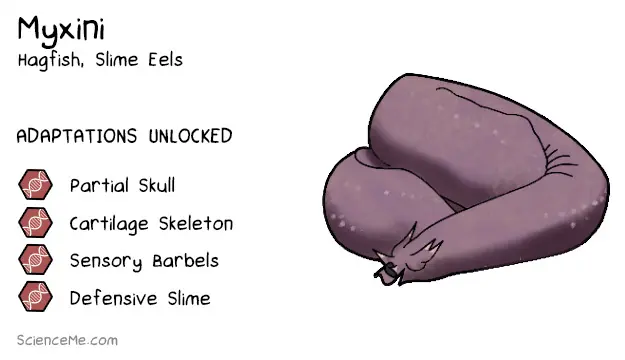
What makes the hagfish special is the presence of rudimentary pseudo-vertebrae. Unusually for a sausage, it also has a brain, eyes, and other sensory organs. While elusive in the fossil record, hagfishes are alive and well today, providing genetic and physiological evidence for their place in the evolutionary tree.
Our next guest is also a face for radio. Lampreys, or Hyperoartia, are early adopters of true backbones. The fossil record reveals their shape has stayed virtually unchanged in 500 million years of animal evolution.
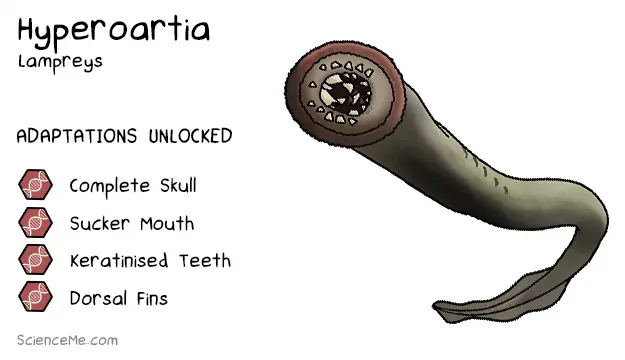
Humans descended from a sister animal of lampreys, who was the first to develop an adaptive immune system, allowing our bodies to recognise and remember pathogens today.
Although now extinct, they likely looked very similar to lampreys, meaning this is what your great-great-great-great-great...etc grandmother looked like. You really have her eyes / tail / sucker mouth.
#11. The Evolution of Jaws
About 430 million years so, natural selection favoured the evolution of jaws and a mineralised skeleton. Welcome to the age of true predators.
Early Chondrichthyes, like sharks and rays, were able to eat big chunks of flesh, so grew bigger and swam faster compared to their ancestors. With such exotic and fast-moving predators emerging, animal evolution raced along (relatively speaking, of course).
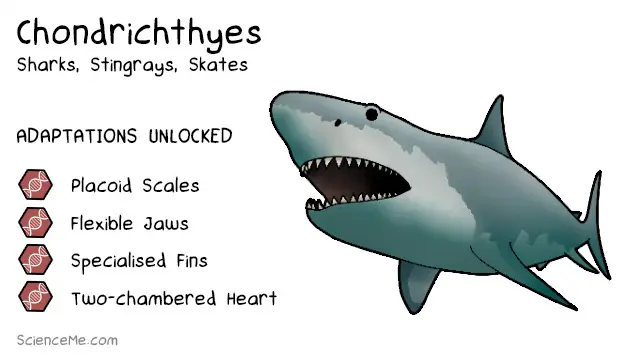
#12. The Evolution of Lungs
You may have noticed that we're still largely in the water along our evolutionary trail. That's because aquatic animals had not developed any capacity to gulp air. Until now.
Sarcopterygii are muscular, lobe-finned fish with bony skeletons, such as lungfish and coelacanths. The latter was thought to have been extinct for 65 million years until, in 1938, a very confused fisherman hauled one in and took it to a local naturalist for identification.
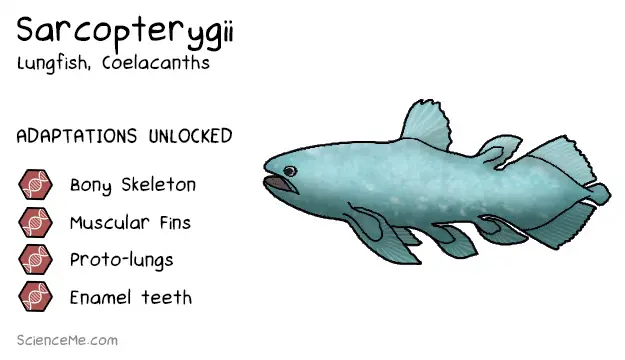
All other fish fall into the phylum of Actinopterygii, or ray-finned fish, which evolved manoeuvrable fins and a swim bladder. For many fish, the swim bladder is a buoyancy aid; an air-filled sac which keeps them at their water depth without having to waste energy on swimming. However, for some, it performs as a rudimentary lung.
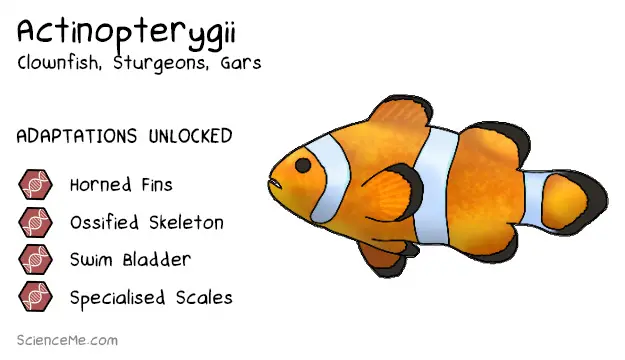
#13. The Evolution of Terrestrialism
By now, the most complex animals on Earth had eyes, brains, backbones, jaws, gills, lungs, and fins. Only relatively small modifications of this body plan were needed to produce the superclass known as Tetrapods.
The recent fossil discovery of Tiktaalik provided the so-called missing link between aquatic lobe-fins and land-dwelling Tetrapods. Nicknamed the fishopod, it's dated to around 385 million years ago.
Like a fish, it had fins, gills, lungs, and scales. But unlike a fish, it had rudimentary ribs (capable of ventilating the lungs), muscular fins (to support its body out the water), and a distinct neck and shoulders (to move its head separately from its body).
Notably, Tiktaalik's fin-feet already had the bone structure common to Tetrapod wrists today. It likely gave rise to the first Tetrapod land dwellers: Amphibians.
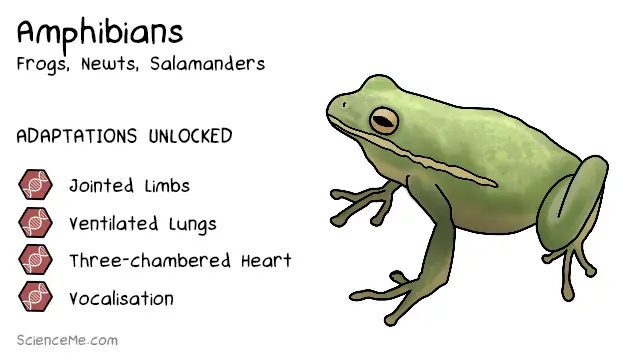
Amphibians include frogs, salamanders, and caecilians. While reasonably comfortable on land, their lives are inextricably connected to the water. Their moist skin and eggs are vulnerable to drying out, so they can never truly explore the far reaches of dry land.
Amphibians also go through quite the metamorphosis early in life, having aquatic larval forms which are distinctly different from their adult forms. Such convoluted lifecycles are evolutionary throwbacks to older animals like jellyfish and tunicates.
#14. The Evolution of Amniotic Eggs
If moist eggs tied Amphibians to water, then hard-shelled eggs would liberate their descendants. Reptiles include some of the most objectively fun animals that ever existed including dinosaurs, snakes, lizards, crocodiles, and turtles.
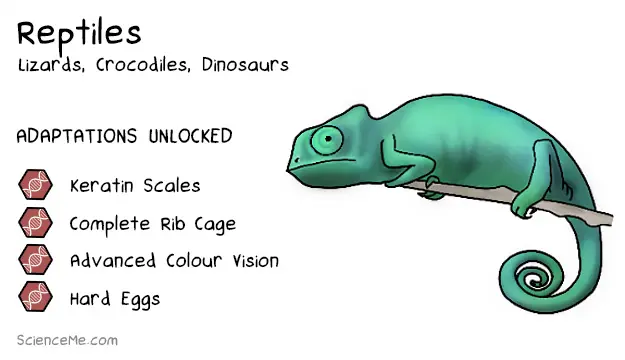
Consider 280-million-year-old Testudines, aka turtles, tortoises, and terrapins. Once possessing teeth, ancient Testudines survived the mass extinction event that obliterated most of the dinosaurs.
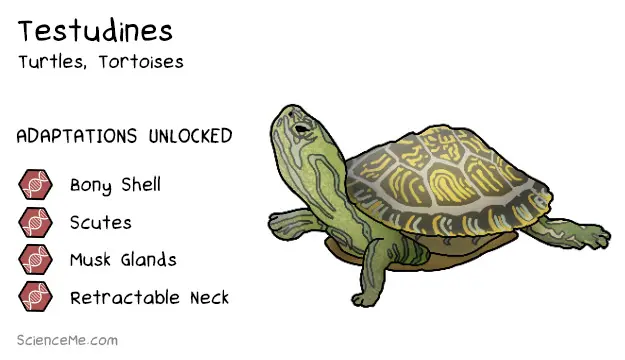
Speaking of which, dinosaurs are a completely different evolutionary branch of reptiles that lived during the Mesozoic Era. They come in two main flavours:
- Ornithischians (meaning "bird-hipped") were mostly herbivores. Some Ornithischians, like Triceratops and Ankylosaurs, evolved thick skulls and armoured plates which protected them from predation.
- Saurischians (meaning "lizard-hipped") included carnivores like Tyrannosaurus Rex and Giganotosaurus, as well as massive long-necked herbivores like Diplodocus and Brachiosaurus.
So what's the link between dinosaurs and birds?
#15. The Evolution of Flight
A number of dinosaurs evolved wings, from Pterosaurs which lived 230 million years ago, to Microraptors which lived 120 million years ago.
As Alan Grant taught us in Jurassic Park, Aves descended from dinosaurs. In fact, Archaeopteryx is widely considered the first bird, and as you very well know, Archaeopteryx was also a dinosaur. Most palaeontologists now agree that birds are types of dinosaurs that evolved 160 million years ago.
Modern birds evolved from as few as three dinosaur lineages about 95 million years ago at the end of the Cretaceous Period. They have amazing adaptations to aid flight, like hollow bones, no teeth, a single ovary, and aerodynamic feathers.
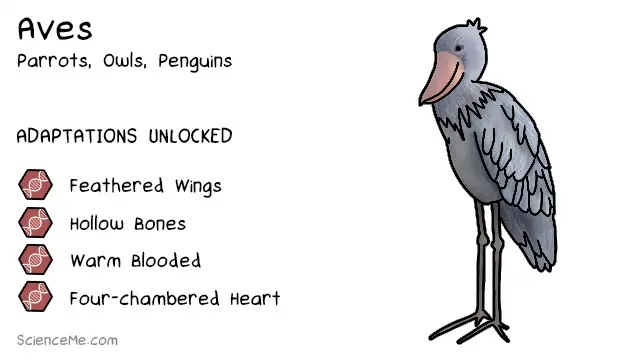
Flight has massive survival benefits in terms of hunting, escaping predation, and migration. Yet some predator-free environments have caused birds to become flightless. When it comes to evolutionary adaptation, you have to use it or lose it.
Kiwis are one of many flightless bird species native to New Zealand, which evolved in geographical isolation for 80 million years. When the Polynesians arrived on the islands with rats in the 13th century, native bird populations took a big hit. The introduction of cats and dogs by European settlers in the 18th century only exacerbated the problem.
Extinctions happen for a number of reasons, but there's always one common feature: the environment changes too rapidly for organisms to adapt. Humans certainly aren't making it easier.
#16. The Evolution of Mammary Glands
By definition, Mammals are animals which have hair and produce milk from mammary glands. I don't know my dad's excuse.
Pseudo-mammals evolved from Reptiles 178 million years ago. By the end of the Triassic period, Mammals were small, hairy creatures which fed on insects at night and still laid eggs. In time, they diversified to a degree, but competition and predation was fierce: dinosaurs already dominated many ecological niches.
Three lineages of Mammals—Monotremes (egg-layers), Marsupials (pouch-bearers), and Eutherians (placenta-bearers)—were already established when most dinosaurs went extinct 65 million years ago due to sudden environmental shifts caused by a very big asteroid.
The Mammals that survived exploited the ex-dinosaur habitats, food sources, and territories, rapidly filling the ecological niches left behind. This was our chance to shine.
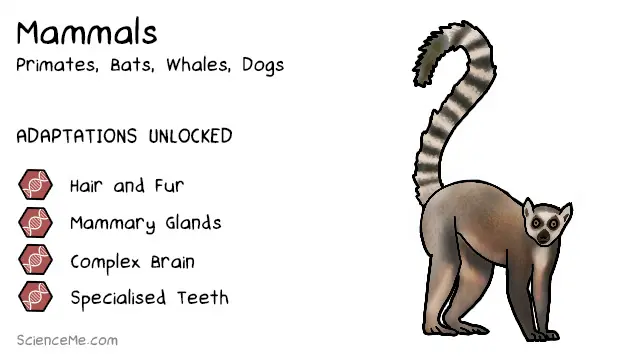
Over the next 65 million years, Mammals diversified into a range of forms and lifestyles. Rodents took to living underground. Primates took to the trees. And Cetaceans said "sod it" and went back to the oceans to become dolphins and whales.
It wasn't until 4.4 million years ago when hominins emerged in the form of Australopithecus. These unusually smart African apes were likely the direct ancestors of modern humans. They thrived for 3 million years before disappearing at the hands of global climate cooling, or competition with other hominin species, or both.
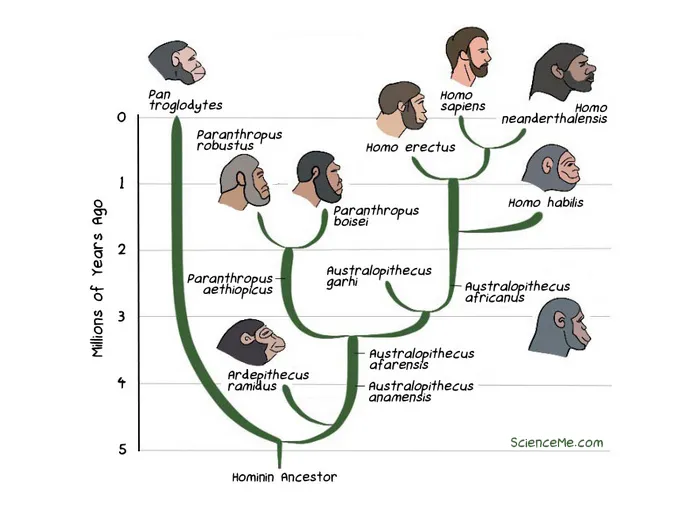
Homo sapiens is the only surviving species of human.
Homo sapiens emerged at least 300,000 years ago. Congratulations for getting this far. You, sir, are fit to survive. Every single ancestor of yours has matured and reproduced without fail for at least 3.5 billion years straight. They didn't know it, but they were all working towards you. And that bloke at the petrol station. And your dentist. And the old lady who stalks you on Facebook. Okay, it doesn't sound so special anymore. But if you can have an ego about it, your evolution is rather wonderful. The fact that we exist means we've won the evolutionary lottery. All 8 billion of us. Even if we do hark back to a slimy old hagfish.
